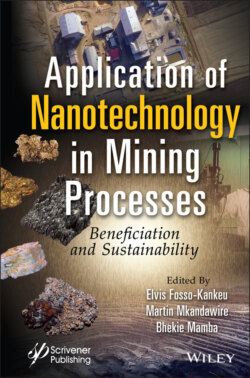Читать книгу Application of Nanotechnology in Mining Processes - Группа авторов - Страница 17
1.3 Dendrimer as Extraction Agent of Rare Earth Element in AMD
ОглавлениеPolymeric materials such as dendrimer nanoparticles have been proven to effectively recover metals from wastewater [52, 53]. Dendrimers are three-dimensional, nanosized polymeric material with great surface chemistry consisting of numerous end groups that can be manipulated or functionalized as modules for a thriving nanotechnology industry [54]. Intensive research studies have been conducted to evaluate the feasibility of retrieving REE from unconventional sources using different techniques (Table 1.4). However, these techniques also have their shortcomings involving cost and, therefore, developing an appropriate cost-effective method to extract them from AMD could make it a perfect source of REE. The use of dendrimers as an absorbent for the removal of metals in solution is a growing trend, and structurally, it has a tree-like branched nature consisting of a central core, an interior and exterior branched cell with the potential of forming more branches through a repetitive synthesis of monomers known as generation growth [55]. The higher generation growth of dendrimers is believed to carry more functional groups on their molecular surfaces. This allows them to interact with solid surfaces, acting as an adsorbent or ligands soluble in water to remove solvated toxic metals [56–58]. The properties of dendrimers are dependent mainly on these functional groups, such as amine, carboxyl, or hydroxyl groups, attached to dendrimers, which are used primarily for adsorption reactions of different targets [55, 59]. For instance, amine-terminated dendrimers, such as polyamido-amine dendrimers (PAMAMs), exhibit a high binding affinity for metal ions to their surface via coordination with the amine or acid functionality [60].
Table 1.4 Recovery of REE using different techniques.
| Types of REEs | Technique(s) used for recovery/extraction |
| Gd | Magnetically retrievable imprinted chitosan/carbon nanotube composite reverse osmosis.Binding on mesoporous silica supports functionalization with diphosphonic acid.Ion exchange on cesium molybdo vanado phosphate immobilized on platelet SBA-15. |
| La, Ce, Pr, Nd, Sm, Dy, Ho, Er, Tm | Adsorption on silica gel modified with diglycol amic acid. |
| Tb | Nano-Mg (OH)2 reaction column.Extraction using solvent-impregnated resin containing TOPS 99. |
| Eu | Sorption on graphene oxide-supported polyaniline composites.Adsorption on graphene oxide nanosheets. |
| Nd | Adsorption on carboxymethyl chitosan adsorbents entrapped by silica. |
| Lu, Yb | Solid-liquid extraction using Tulsion CH-96 resin. |
